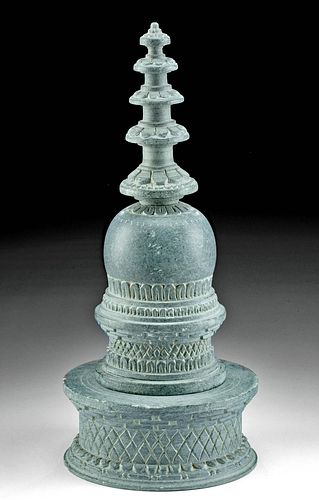2nd C. Gandharan Schist Reliquary in Form of Stupa
Lot 124a
About Seller
Artemis Gallery
686 S Taylor Ave, Ste 106
Louisville, CO 80027
United States
Selling antiquities, ancient and ethnographic art online since 1993, Artemis Gallery specializes in Classical Antiquities (Egyptian, Greek, Roman, Near Eastern), Asian, Pre-Columbian, African / Tribal / Oceanographic art. Our extensive inventory includes pottery, stone, metal, wood, glass and textil...Read more
Categories
Estimate:
$6,000 - $9,000
Absentee vs Live bid
Two ways to bid:
- Leave a max absentee bid and the platform will bid on your behalf up to your maximum bid during the live auction.
- Bid live during the auction and your bids will be submitted real-time to the auctioneer.
Bid Increments
| Price | Bid Increment |
|---|---|
| $0 | $25 |
| $300 | $50 |
| $1,000 | $100 |
| $2,000 | $250 |
| $5,000 | $500 |
| $10,000 | $1,000 |
| $20,000 | $2,500 |
| $50,000 | $5,000 |
| $100,000 | $10,000 |
| $200,000 | $20,000 |
About Auction
By Artemis Gallery
Oct 7, 2021
Set Reminder
2021-10-07 10:00:00
2021-10-07 10:00:00
America/New_York
Bidsquare
Bidsquare : Exceptional Antiquities Ethnographic Fine Art
https://www.bidsquare.com/auctions/artemis-gallery/exceptional-antiquities-ethnographic-fine-art-7537
Museum-worthy examples of Egyptian, Greek, Roman, Etruscan, Near Eastern, Far East / Asian, Pre-Columbian, African / Tribal, Oceanic, Native American, Spanish Colonial, Fossils, Ancient Jewelry, Fine / Visual Arts, so much more! Artemis Gallery info@artemisgallery.com
Museum-worthy examples of Egyptian, Greek, Roman, Etruscan, Near Eastern, Far East / Asian, Pre-Columbian, African / Tribal, Oceanic, Native American, Spanish Colonial, Fossils, Ancient Jewelry, Fine / Visual Arts, so much more! Artemis Gallery info@artemisgallery.com
- Lot Description
Ancient Central Asia, Pakistan, India, and Afghanistan, Gandharan Empire, ca. 2nd century CE. A gorgeous reliquary in the shape of a tiered stupa, hand-carved from gray-green schist and smoothed until it achieved pleasingly tactile surfaces. The stupa model consists of a circular, spool-form base with a densely incised crosshatch band between two castellated registers; a deep central well is intended to hold the middle portion. The central component features a nearly spherical top portion above another spool-form midsection, each decorated with programs of tongues, tabs, crosshatch motifs, and castellated patterns. The top finial features five gradually narrowing tiers stacked atop one another, each with several flower petals adorning the circumference, all resembling a spiraling pagoda. Each component fits with a tenon inside the mortise of the others to create a sumptuous, elegant, and visually striking reliquary! Size: 5.3" W x 11.9" H (13.5 cm x 30.2 cm)
According to the Metropolitan Museum of Art's Heilbrunn Timeline, "Stupas, the earliest Buddhist monuments preserved in India, began as solid hemispherical domes that marked the remains of a great leader or teacher. They were incorporated into early Buddhist art as symbols of the continuing presence of Shakyamuni Buddha after his parinirvana (final transcendence), and as reminders of the path he defined for his followers. Buddhism carried the stupa throughout Asia, where it was interpreted in many forms, including the domed chortens of Tibet and the spired pagodas of China, Korea, and Japan."
Cf. The Metropolitan Museum of Art, accession number 1987.142.43a-c as well as 1987.142.96a-c
Cf. a relief panel with a similar stupa at The British Museum, museum number 1902,1002.29
A larger example with an accompanying rectangular base hammered for EUR 67,000 ($78,524.00) at Christie's, Paris "Art d'Asie" auction (sale 5598, June 8, 2010, lot 420)
This piece has been searched against the Art Loss Register database and has been cleared. The Art Loss Register maintains the world's largest database of stolen art, collectibles, and antiques.
Provenance: private Southern California, USA collection, acquired through descent 2006; ex-private California, USA collection, before 2000
All items legal to buy/sell under U.S. Statute covering cultural patrimony Code 2600, CHAPTER 14, and are guaranteed to be as described or your money back.
A Certificate of Authenticity will accompany all winning bids.
PLEASE NOTE: Due to recent increases of shipments being seized by Australian & German customs (even for items with pre-UNESCO provenance), we will no longer ship most antiquities and ancient Chinese art to Australia & Germany. For categories of items that are acceptable to ship to Australia or Germany, please contact us directly or work with your local customs brokerage firm.
Display stands not described as included/custom in the item description are for photography purposes only and will not be included with the item upon shipping.
#168093All components have minor abrasions and very light softening to some incised details, otherwise intact and near-choice. Wonderful preservation to incised details, with light earthen deposits and impeccably smooth surfaces throughout. Old inventory labels within lower mortise of central component.Condition
- Shipping Info
-
All shipping is handled in-house for your convenience. Your invoice from Artemis Gallery will include shipping calculation instructions. If in doubt, please inquire BEFORE bidding for estimated shipping costs for individual items.
-
- Buyer's Premium



 EUR
EUR CAD
CAD AUD
AUD GBP
GBP MXN
MXN HKD
HKD CNY
CNY MYR
MYR SEK
SEK SGD
SGD CHF
CHF THB
THB















